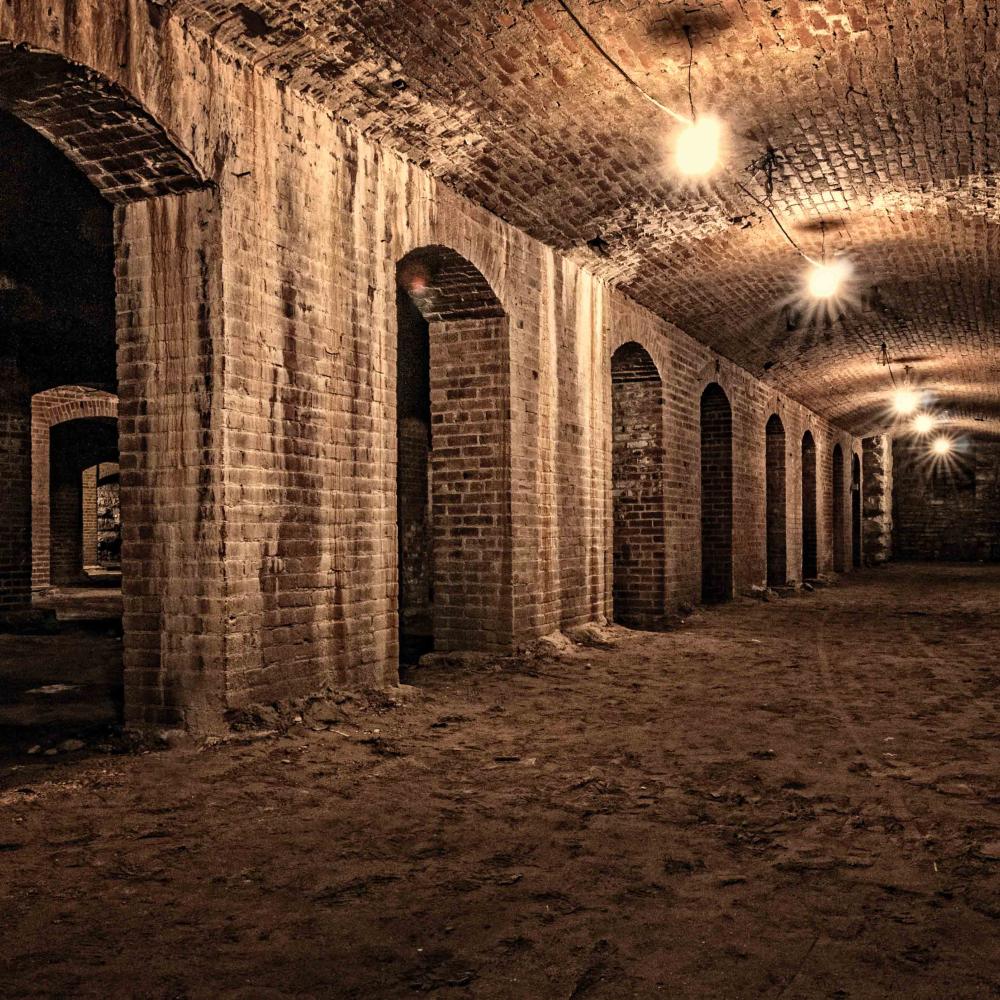When I learned of a historic tunnel system underneath the City Market, approximately 20,000 square feet of hidden space that lies beneath downtown Indianapolis, I couldn’t wait to take my boys and nephew on a tour of what is called the Catacombs.
I love learning about Indianapolis. So much of my writing revolves around the theme of identity. A major element of any story is its setting and how a place shapes a person. Part of interrogating my own identity is investigating the place I call home. Indianapolis is America in a microcosm, the events that shaped the nation woven into the very fabric of the city. That said, I love to take tours of “haunted” or “historic” Indianapolis, to learn its secret stories. The history they didn’t teach us in school.
In 2016, when I first visited the Catacombs, I was brainstorming how to turn my short story, “Pimp My Airship,” into a novel. That had been my first steampunk story. (If you don’t know about the steampunk sub-genre, think a tale with nineteenth-century ethos and architecture, yet with futuristic, steam-powered technology. It features a retrofuture aesthetic rooted in the Victorian era’s perspective on fashion, culture, architectural style, and art. Things like Wild Wild West, League of Extraordinary Gentlemen, or Twenty Thousand Leagues Under the Sea.) I wanted to explore the idea of how a writer—in this case, an open-mic poet named Sleepy—could use their art to leverage change in their community. But I needed to know where he came from.
The Catacombs are located under Whistler Plaza, as the foundation for the massive Tomlinson Hall, a building that once stood beside City Market and could hold up to 3,500 people. The Catacombs were used to transport and store meats and produce to be sold in the market. A fire in 1958 burned down portions of the area including most of Tomlinson Hall. At one point, the underground structure was used for shelter by the homeless during bad winter storms. Even as I walked up to City Market, I couldn’t help but imagine Indianapolis streets, what they looked like more than 100 years ago. Teeming with people, wagons, and horses. Trolleys. Folks bustling about their business, shopping, gathering for meetings.
The modern City Market plaza is a one-story, rectangular brick building trimmed in limestone. Its gable center, flanked by square towers, is now a food hall. An unassuming stairway leads to the Catacombs. A dirt floor lined with plywood to walk on leads into the grand gallery of what used to be. A series of passages and walkways, brick archways, and limestone columns give the illusion of a labyrinth. The space is eerie, with haunting lighting creating pockets of shadow. The plink plink plink sound of water dripping in the distance. The occasional jutting pipe, the strange echoes of an old structure. All deep underground, beneath the very feet of folks going about their daily business, unaware of what surrounds them, like long-buried secrets. The boys ran off to explore every nook. There came a moment when I, too, wandered off or fell behind. I ran my hand along a limestone column. Its chill ran through my fingertips, almost to the bone. The way the walls closed in, I couldn’t help but think of being locked in a tomb. The voice of the tour guide brought me back, but the idea of the city that “was” fascinated me.
Architecture tells a story. Architecture captures history, our values, and what we considered important. Historically, steampunk ignored the darker aspects of the Victorian era, such as colonialism, sexism, classism, racism, and chattel slavery. In my steampunk world—from “Pimp My Airship” to “Steppin’ Razor” to Buffalo Soldier to the nearly dozen other short stories set here—America lost the Revolutionary War and remains a colony of Albion. The legacy of slavery and colonialism have sown the seeds of racialism. Oppressive societal control systems have been built. And in this cauldron of racist systems, the city of Indianapolis—and the people who live there—struggles to figure out what it wants to be. Thus began the worldbuilding of the Indianapolis that became the setting of Pimp My Airship.
In the novel, the Catacombs become their own underground city known as “The Tombs.”
The Tombs—the undercity of Indianapolis—languished in the eternal night of the lower avenue. Its residents lived in the shadows of the downtown spires—sunlight parceled out in dribs and drabs—in the reflections of a better life. The tunnels beneath the city were old when Indianapolis was founded. Some whispered that this was the original Indianapolis and the overcity was built over it like some steam-fueled clockwork tombstone burying its past.
In Pimp My Airship, all the poet called Sleepy wants to do is spit his verses, smoke chiba (their term for marijuana), and stay off the radar of the COP (City Ordained Pinkertons). All of which becomes impossible once he encounters a professional agitator known as (120 Degrees of) Knowledge Allah. Sleepy and Knowledge Allah have grown up in communities isolated by redlining, forgotten and abandoned in the undercity known as The Tombs. Beneath the comic romp, these accidental revolutionaries have to navigate systems of an overpoliced state, mass incarceration, and an industrial-military complex.
In The Tombs, gas-lit lamps illumined every intersection, showering huddles of men in their flickering light as they shot dice. Old men huddled in puddles of light, drinking brandy and smoking cigars blunted with chiba. Their garrulous conversation of the most impolitic kind filled the night with the bluster of oafs. A twinge of jealousy at not being able to join in fluttered in Sleepy’s chest. . . . The Tombs were filled with Unpersons who managed to escape being sent to The Ave. But they lived as refugees in their own country. His earliest memories involved running through the musty catacombs, heedless of the rats, playing tag with his friends through the alleyways. He spent many a night bundled in hemp blankets. After a few years, his parents managed to move to the Meadows and later to Freetown Village. Once he moved to the northwest side, he never looked back.
This was the passage I read as part of Indiana Humanities’s Bookmark Indy program, a literary exploration of Indianapolis through the eyes of the writers who’ve called it home. Pimp My Airship won the 2020 Eugene and Marilyn Glick Indiana Authors Award for Genre. The Catacombs were my inspiration, part of what defines Indianapolis as home for me. By incorporating my city’s strange, underground realm into my fiction, I am able to share it as more than just a physical place, but as a connected story. Because that’s what history is: the collection of stories that shaped people, the events that formed cities, nations, the world we know. We shouldn’t hide from those stories or, in any way, risk burying the past and thus robbing ourselves of opportunities to learn the lessons of those stories. Taking my family, we learn the history, discuss its ramifications, and dream of better futures. And in so doing, we hope to leave behind a rich heritage of stories.


